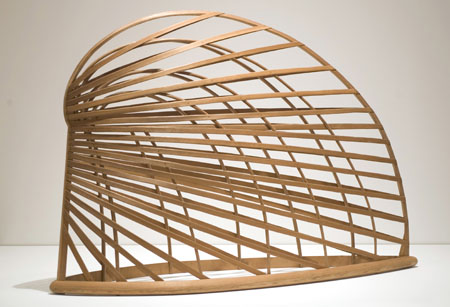 Martin Puryear. Bower. 1980. Sitka spruce and pine. 64" x 7' 10 3/4" x 26 5/8" (162.6 x 240.7 x 67.6 cm). Smithsonian American Art Museum, Washington D.C.
Martin Puryear. Bower. 1980. Sitka spruce and pine. 64" x 7' 10 3/4" x 26 5/8" (162.6 x 240.7 x 67.6 cm). Smithsonian American Art Museum, Washington D.C. There is so little mystery in many of today's most famous painters whose lives are readily available for public consumption. But interestingly, Martin Puryear's work, which is also on view shares a certain quiet reflectiveness , a stand-aloneness that shouts out:Puryear came from segregated Washington DC and so access to the National Gallery was special and magical; then in Chicago, the science and natural history museums added to his fascination with exotic objects. He enlisted in the Peace Corps and lived in West Africa among indigenous peoples; here, he began the move towards abstraction and to using local materials. But he has never joined an art movement and cannot imagine being held to one or another political or social idea. He began as a figurative painter but his experiences overseas changed him dramatically, and unlike many artists, he doesn't mind if his work is beautiful--and indeed it is. But in a Seurat-ian echo, he finds the most interesting art has a "flickering quality where opposed ideas can be held in tense coexistence." As Seurat sees the sculpture in the human body, Puryear sees the biomorphic forms in sculpture. Puryear's work has one other subtext which stands out: it feels like he has been thinking about the evanescence of the natural environment--and that in a pinch, we could crawl into one of his bentwood structures and be protected, somehow from the ravages of man, if not nature.

No comments:
Post a Comment